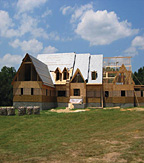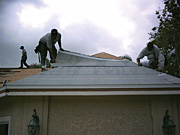
However, synthetic and alternative underlayments are a growing trend for steep-slope roofing. Perimeter leaks, energy conservation and material shortages have contributed to a boom in sales, according to several manufacturers. A critical mass was reached when last year's hurricane season created a need for countless roofs to be dried-in quickly but had to sit without a covering for months at a time, something that would wither your father's 30-pound felt. Last January, TARCO introduced to the Florida market Fast 90, a peel and stick underlayment geared toward tile roofs. It can withstand up to six months of exposure and stacks of tile awaiting installation.
"It's taking off like wildfire," says Steve Ratcliff, president of TARCO in Little Rock, Ark., a major manufacturer of traditional asphalt felts. "All the roofers want to get away from hot mop and torch because they can't find anybody to install them."

Felt Like a Change
Like many roofing products, felts were once an added feature but became an industry standard, so much so that people take the term "dried-in" literally. It's hard to screw up a 30-pound asphalt felt-though some have succeeded-but as quality and price became uniform the purchase decision was determined by inertia. Built-up manufacturers could keep their machines running during the offsetting cycles between commercial and residential construction, but any innovation was made to the shingle itself. Felts did their job reasonably well and kept quiet.Then leaks around valleys and hips were appearing; ice dams were backing up water. Grace Construction Products was first on the scene around 25 years ago when it took underground waterproofing technology and applied it to a roofing underlayment. Like a waterproof flashing, penetrations and perimeters could be sealed with confidence. Houses also became wrapped in vapor retarders so the stage was set for more robust roofing underlayments.
The International Roofing Exposition in Orlando last February featured a number of manufacturers offering synthetic underlayments, many with polymer-based reinforcements that are much tougher and can cover several times more area per roll. Though more expensive than fiberglass reinforced asphalt felts, producers of the synthetic felts claim that their products will save labor, reduce waste, and allow them to leave the underlayment in place for months.
"It's a big selling point," says Mickey Gay, vice president of sales and marketing for Alpha Perma R Products, Grenada, Miss. "One of the benefits for us is you don't have to be in a hurry to get the shingles down. And you're not redoing your work."
Alpha Protector SUL was introduced this year at the Home Builders show and has already becoming a hot product, according to Gay. Established in 1982, the company had been making house wraps for five years when it discovered that homebuilders wanted a resilient, high performing underlayment. The recent shingle shortage, plus a demand for metal roofing, has upped the ante for underlayments that can stay put for a while. Gay says that Alpha Protector SUL can be left for up to six months and comes with a 25-year warranty on the material. The product also comes with pre-printed nail guides on a gray coating that's much cooler for crews in the Sunbelt.
Another feature that became a significant factor is slip resistance. Peel and stick asphalt membranes were great waterproofers but were like walking on a smooth-surface BUR, at a 3 in 12 pitch. Synthetic underlayments needed a surface that could not just withstand foot traffic but give it some grip. Like other producers, Gay's product has slip resistance built in.
"We have a technology on our slip resistance that's used in hospital garments," he says. "That's the key to what everybody is trying to create, slip resistance."
Titanium-UDL, from Interwrap, Toronto, was introduced three years ago, after some history in Europe, and has taken off with homebuilders and residential roofing contractors, according to Miriam Nasiri, marketing coordinator. It can be installed in a range of temperatures, left exposed for up to six months, resists mold and comes with a 25-year limited warranty. The company also heavily promotes its patented Sure-Foot nodules to provide slip resistance. "That's probably the most revolutionary feature," says Nasiri. "It's definitely one of the biggest advantages."
She adds that confidence in the product was enhanced when the exposed underlayments in Florida withstood multiple hurricanes, a plus when blue tarps from FEMA had to be applied several times last year. The ubiquitous gray color also provides a cooler surface, making it easier on workers and even offering the potential for lifetime energy savings. The company will be introducing a peel and stick version of its product this summer.
Peel Out
Such developments were quickly learned from the brief history of synthetic underlayments. Early products were black to mimic traditional felts but they were too hot to work with; at least one manufacturer quickly found out that a white product gave off blinding light. The industry seems to have settled on the light gray and knows the importance of slip resistance. Some say an advantage is gained by waiting for the market to build and bugs to be worked outThese underlayments are quickly moving out of the niche product category after a season of material shortages and rising prices for anything made of asphalt. It represents an opportunity for some small manufacturers to upgrade someone else's polypropylene reinforcement and replace a product that been a mainstay for decades.
Innovative Building Solutions is a sales and marketing agency that helps bring new products to market through traditional distributors. Last year, the company picked up the marketing rights in the United States for Soprema's synthetic underlayment. Steve Carroll, owner of IBS, saw the need for better underlayments in high-end projects, particularly those where a small uptick in price wouldn't be noticed. Even though shipping costs don't register much with roofing contractors, his ability to ship 1.3 million square feet in a truckload means the Canadian plant has increased its market universe.
"I think it's a pretty big consideration," Carroll explains. "I can ship from Canada to Florida without having to worry about freight. Distributors love it because I just saved them four fifths of their warehouse space."
With certain exceptions, the product can even be stored outdoors. He says contractors can leave rolls in the back of their truck for the next job without worrying about tearing them up. He doesn't believe that felt manufacturers are going to be crying much over revenue losses from fiberglass felts when they would much rather produce the more profitable laminated shingles.
TARCO is not sitting by but stepping into the fray with an asphalt-based, 90-pound peel-and-stick product. Ratcliff, who spent 20 years in roofing including a stint with Allied Signal, joined the company in 2000 to identify new markets. He knew that tile roofing was exploding in the Sunbelt, especially in Florida where inclement weather demands a waterproof underlayment. Like the synthetic underlayments, his mineral-surfaced Fast90 can be left in place for months, a necessity in Florida. "Even before the hurricanes, there was a five-month waiting period for tile on the job," he says.
The company, established in 1978 with plants in Arkansas, Texas and Pennsylvania, had previously made cap sheets that were applied with a cold mastic or nailed down. Still, contractors were still hot mopping or torching down mineral-surfaced felts partly because the growing popularity of foam adhesion for tiles in Florida required a granular surface. Ratcliff then had a "Eureka" moment when he thought about using the peel-and-stick concept on a robust membrane that could be left out for long periods.
"This was something that just hit me one morning," he says, adding that a patent has been applied for. "The roofers like it because they're really comfortable with it. They've been using 90-pound felts for years."
The first Fast90 was shipped last year and Ratcliff is concentrating on the Florida market for now. It's a dramatic move for the commodity producer. While others have written off asphalt felts as dinosaurs, his attempt to rejuvenate their thinking may have far reaching impact. After all, when the underlayment performs like a membrane, which product is really protecting the building? Innovations in roofing underlayments will compel the industry to view them in a new light. "We're trying to move up the food chain a little," says Ratcliff. "People change their view of the company when you bring out something like this."
Report Abusive Comment